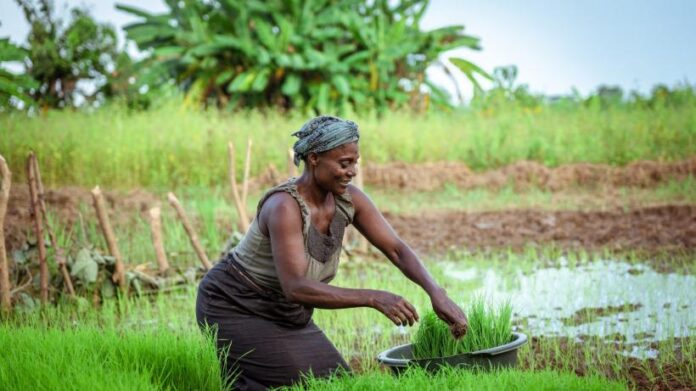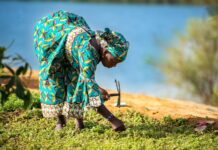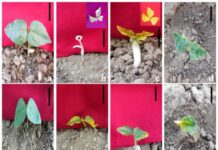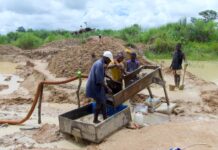Illustrative Image: Climate Change Adaptation in African Mountain Regions: How Smallholder Farmers Cope and Innovate
Image Source & Credit: IGC
Ownership and Usage Policy
A recent study by Cuni-Sanchez et al. (2025) titled “Perceived climate change impacts and adaptation responses in ten African mountain regions” published in Nature Climate Change reveals that smallholder farmers in African mountain regions adapt to climate change mainly through small, incremental measures, hindered by limited resources and governance support.
“
African mountain farmers mainly use small, incremental adaptations, constrained by resources, governance, yet show potential for transformative change. – Cuni-Sanchez et al. 2025
The study presents a comprehensive assessment of how smallholder farmers across Central and East Africa perceive and respond to the growing challenges of climate change. Conducted across ten mountain regions in eight countries—Cameroon, the Democratic Republic of the Congo, Uganda, Ethiopia, Kenya, Burundi, Rwanda, and Tanzania—the research involved 1,500 smallholder farmers (150 per site) through detailed questionnaires and focus group discussions. The central aim of the study was to understand how farmers perceive climate change impacts, identify the adaptation strategies they employ—whether incremental (small adjustments) or transformational (fundamental system shifts)—and examine the constraints and opportunities that influence their ability to adapt.
Climate Change Impacts
Across the surveyed regions, farmers consistently reported reduced rainfall and stream flow, declining crop yields and milk production, and increased soil erosion, pests, diseases, and human health problems. A reduction in fog—a key factor in maintaining moisture for crops—was also observed in some mountainous zones. Region-specific challenges included landslides and coffee yield decline in coffee-dependent areas, as well as rising incidences of malaria, respiratory illnesses, and waterborne diseases linked to changing climatic conditions.
Adaptation Responses
Farmers have adopted a range of on-farm and off-farm strategies to cope with these challenges. On-farm measures include changing planting dates, adopting improved crop varieties, increasing the use of fertilizers, pesticides, irrigation, and soil conservation techniques, and even re-sowing seeds if the first attempt fails. Off-farm adaptations include diversifying income sources through labor work, timber trading, small businesses, and in some cases, mining activities.
Indigenous and Local Knowledge (ILK) continues to guide many farmers’ decisions, especially in determining planting times. However, the reliability of traditional indicators is declining as climate patterns become less predictable.
Constraints and Opportunities
The study identifies several barriers that limit effective adaptation: restricted access to land, credit, and infrastructure, violent conflicts in some regions (notably Cameroon and DRC), and unfavorable agricultural policies. Despite these constraints, there are significant opportunities. Farmers demonstrate high awareness of climate change, growing mobile phone access that enhances information sharing and market connectivity, and benefit from the presence of NGOs and government initiatives. Moreover, many farmers display a strong entrepreneurial spirit and a willingness to experiment with new methods, signaling potential for scaling up successful practices.
Nature of Adaptation
Overall, the majority of adaptation efforts across the ten regions remain incremental, reflecting minor adjustments within existing systems rather than major shifts. However, Mt. Kenya, Mt. Kilimanjaro, and the Bale Mountains exhibit early signs of transformational adaptation. These sites are distinguished by robust social networks, external institutional support, and high levels of farmer innovation, enabling more profound, system-level changes in farming practices.
How the Study was Conducted
The study employed a mixed-methods approach, integrating quantitative surveys and qualitative insights to provide a holistic understanding of how smallholder farmers perceive and respond to climate change. The authors surveyed 1,500 smallholder farmers (150 per site) across ten mountain regions in eight African countries, using structured household questionnaires to gather information on observed climatic changes, biophysical impacts such as crop yield fluctuations and livestock health, and the specific adaptation strategies implemented. To ensure cultural and ecological relevance, focus group discussions (FGDs) were held with village elders before administering the surveys. These discussions helped refine the questionnaire by identifying locally specific impacts and responses—for instance, including coffee-related questions only in coffee-growing regions. This participatory step grounded the research in indigenous and local knowledge (ILK), incorporating farmers’ traditional methods of predicting seasonal changes and interpreting environmental cues.
The study applied a comparative case study framework to discern both shared adaptation patterns and site-specific differences across the ten regions. Using mixed-effects models, the authors explored relationships between perceived climatic changes and the diversity of adaptation responses, while socioeconomic stratification analysis assessed how household wealth shaped the type and number of adaptation actions taken. A collaborative reflective analysis among co-authors further deepened interpretation, identifying key constraints and opportunities influencing adaptation capacity. Adaptation measures were categorized as incremental (small, short-term adjustments) or transformational (fundamental shifts in livelihood systems), drawing on frameworks adapted from IPCC guidelines and established literature on adaptation typologies.
What the Authors Found
The study found that smallholder farmers in African mountain regions are actively adapting to climate change but mostly through incremental, small-scale adjustments rather than transformative changes, due to persistent structural constraints such as limited access to land, credit, and supportive governance.
Despite high climate change awareness and a strong reliance on indigenous and local knowledge, farmers’ adaptation efforts remain constrained by socioeconomic and institutional barriers. However, the study highlights emerging pockets of transformational adaptation—particularly in Mt. Kenya, Mt. Kilimanjaro, and the Bale Mountains—where strong social networks, farmer innovation, NGO support, and remittances from younger generations are driving more sustainable, systemic shifts.
Why is this important
Filling a Research Gap
The study brings long-overdue attention to African mountain regions—home to over 228 million people—highlighting their vulnerability to climate change and addressing a major gap in global adaptation research, which has largely focused on lowland areas.
Ground-Level Evidence of Climate Impacts
It provides detailed, community-based evidence of local climate impacts—such as reduced fog, lower crop yields, and increased disease—offering insights often missed by large-scale climate models and emphasizing the value of indigenous knowledge.
Mapping Adaptation Pathways
By distinguishing between incremental and transformational adaptation, the study clarifies how farmers are coping and which communities are making systemic changes, guiding targeted interventions for greater climate resilience.
Identifying Barriers and Opportunities
The research reveals critical barriers—like limited access to credit, infrastructure, and peace—while highlighting enablers such as mobile connectivity, strong social networks, and farmer innovation that can be leveraged for wider impact.
Guiding Policy and Practice
Its findings offer actionable insights for policymakers, NGOs, and development partners to design context-specific adaptation strategies, ensuring that climate resilience efforts are informed by both scientific and local perspectives.
What the Authors Recommended
- The study advocates improving financial inclusion and market connectivity through innovative financing models, partnerships with NGOs and the private sector, and infrastructure investments. Support market awareness and product certification (e.g., organic coffee) to increase farmers’ income and resilience.
- The author emphasises fostering ongoing collaboration between farmers, extension agents, NGOs, and researchers. Move beyond one-off technology transfers by co-designing adaptation strategies that align with local values and ecological contexts. Encourage peer learning and farmer-led experimentation.
- Furthermore, ensure national policies are context-sensitive and inclusive by assessing their impacts on different social groups. Address the challenges posed by conflict, political instability, and weak governance through localized policy design, peacebuilding efforts, and targeted support for vulnerable regions.
- In addition, embrace coproduction—joint knowledge creation between communities and researchers—as a guiding principle. This participatory process builds trust, reveals hidden local challenges (such as security concerns), and enables the development of transformational adaptation pathways that are socially and ecologically grounded.
In conclusion, the study by Cuni-Sanchez et al. (2025) underscores that smallholder farmers in African mountain regions are actively responding to climate change, primarily through incremental adaptations shaped by local knowledge, social networks, and resource constraints. While structural barriers—such as limited land access, credit, infrastructure, and governance challenges—continue to restrict transformative change, emerging examples in Mt. Kenya, Mt. Kilimanjaro, and the Bale Mountains demonstrate the potential for systemic, sustainable adaptation. By highlighting both the challenges and opportunities faced by these communities, the research provides critical insights for policymakers, NGOs, and development partners to design context-sensitive, participatory strategies that enhance resilience, support innovation, and foster long-term climate adaptation in these vulnerable mountainous landscapes.
















 The African Research (AR) Index is a comprehensive scholarly directory and database focused explicitly on journal publishers that publish and disseminate African research.
The African Research (AR) Index is a comprehensive scholarly directory and database focused explicitly on journal publishers that publish and disseminate African research.

